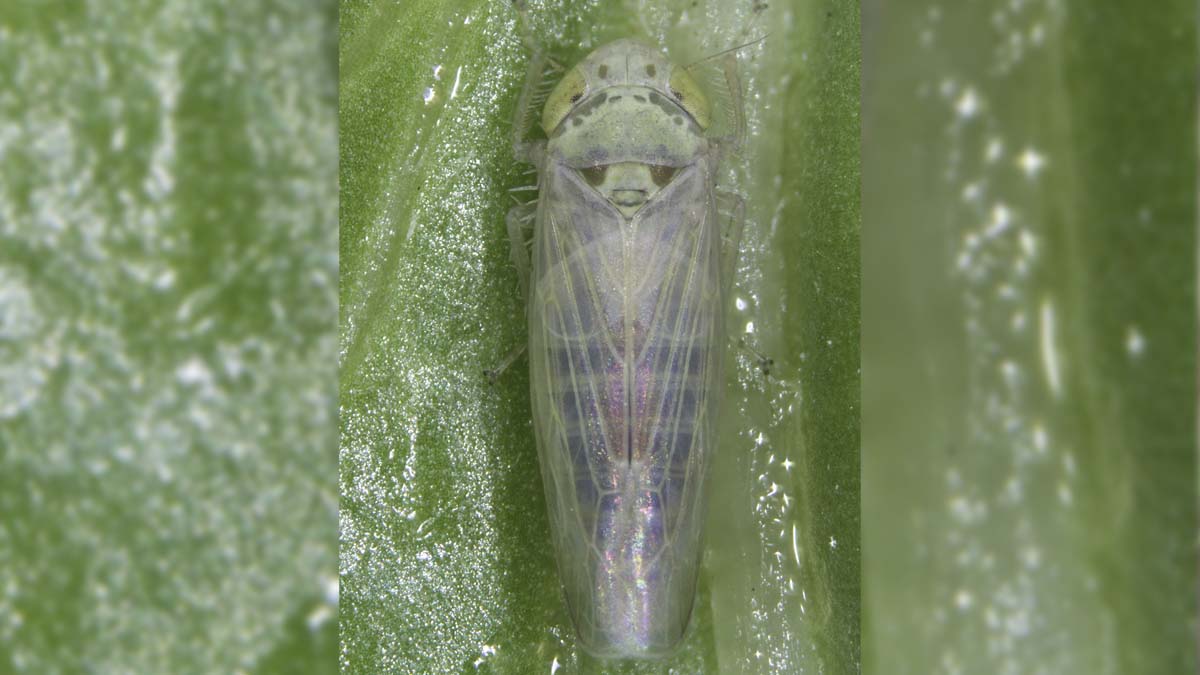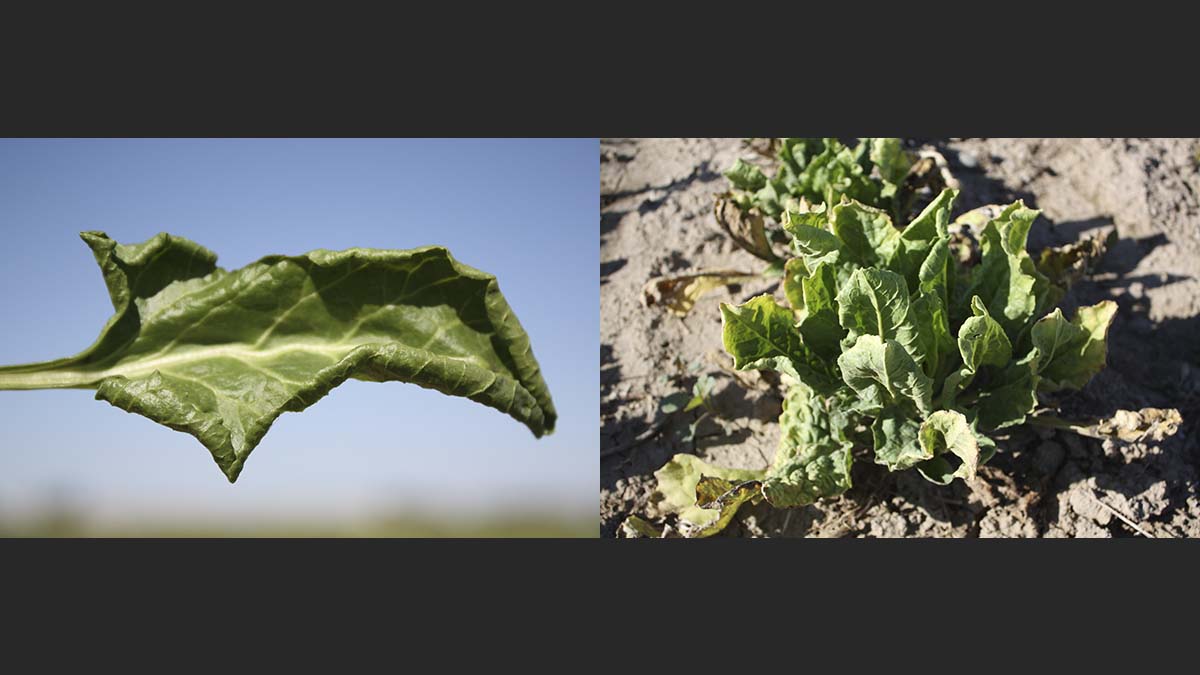Leafhoppers
Pest Common Name
- Beet leafhopper (Circulifer tenellus)
- Others including the Intermountain potato leafhopper (Empoasca filamenta) and aster leafhopper (Macrosteles quadrilineatus)
- Potato, beets, tomato, beans, pepper, others
- Weeds: mustard family weeds, kochia, Russian thistle, pigweed, shepherd’s purse, sagebrush, others
Adult leafhoppers are small, wedge-shaped insects with membranous wings held tent-like above the body. Nymphs are similar in appearance, though often lighter in color and smaller, with underdeveloped wings. Eggs are not visible, as they are laid inside plant tissues. As the name suggests, leafhoppers tend to move in rapid, short flights that resemble hopping.
Beet leafhoppers (Figure 1) vary in coloration, but are usually pale green to gray to tan, and may develop darker coloration later in the season. Beet leafhoppers can often be differentiated from some other leafhopper species by the lack of a dark spot on the head. Adults are around about 1/8 in (3 mm) long.
Intermountain potato leafhoppers are greenish to yellowish with lighter-colored legs and tend to be about 1/8 in (3 mm) long as adults.
Aster leafhoppers are usually olive-green, and 5/32 in (4mm) long, and have three pairs of spots on the top of the head.

Biology
The lifecycle of leafhoppers consists of three general stages: egg, nymph and adult. There are multiple growth phases, or “instars,” of nymphs. Adult beet leafhoppers overwinter in weedy or uncultivated areas. Overwintering females begin laying eggs inside of plant tissues around March. Around May the eggs mature into adults, which may then move into cultivated fields. The timing of this movement depends on when spring hosts become dry and unsuitable for leafhoppers. Leafhoppers may disperse from overwintering sites to nearby fields, or they may sometimes migrate further on wind currents. This generation of migrants can then lay their own eggs on plants in cultivated fields. Several generations may ensue, with the final generation usually maturing around September or October, at which point adult leafhoppers seek overwintering hosts.
Damage
Leafhoppers pierce plant tissues to feed on nutrient-rich plant sap. Adults and nymphs both cause damage, but the final nymphal instar in the most damaging (Figure 2). Leafhopper feeding can directly weaken plants, causing leaf curling and growth stunting when leafhopper populations are large. Leafhoppers can also cause serious damage by transmitting a number of disease-causing pathogens in potato, including Beet Curly Top Virus (BCTV), witches’ broom and beet leafhopper-transmitted virescence agent (BLTVA). Purple top, caused by BLTVA, is the leafhopper-transmitted disease of primary concern in potato in the northwest. The importance of the other pathogens associated with leafhoppers is less clear.
Of the leafhoppers that affect potatoes in Idaho, the beet leafhopper (Circulifer tenellus) is of greatest concern as it transmits the virulence agents responsible for purple top and BCTV.
Purple top symptoms in potatoes include rolling of leaf tips, leaves developing purple coloration, and death of interveinal leaf tissue. Tubers are often numerous, small, soft and flabby. Symptoms of purple top can be mistaken for psyllid yellows or zebra chip diseases.
Curly top symptoms in potatoes include yellowing and curling of leaves. Tubers are small or completely absent, and aerial tubers may form. See Curly Top Pest Profile for more details.
The intermountain potato leafhopper (Empoasca filamenta) is less destructive than the beet leafhopper, causing speckling or white stippling on lower leaves of plants.

Monitoring
Scouting should begin at potato emergence and extend through the growing season. Monitoring using yellow sticky cards placed 5-10 feet (1.5-3 m) from field edges is recommended. Try to achieve thorough coverage of field edges, as leafhopper distribution can be uneven. Sticky cards will catch the most beet leafhoppers when placed only a few inches above the ground and kept free of weeds. Check and replace sticky cards weekly. There are no established treatment thresholds for leafhoppers in potato, but if yellow sticky cards capture between 40 and 100 beet leafhoppers per week, or 1-2 beet leafhoppers are found per potato plant, control measures may be warranted.
Management
Primary Management Tactics
Managing weed hosts reduces leafhopper overwintering habitat and pathogen hosts. Insecticides applied when leafhoppers are dispersing into potato may provide good control for leafhoppers and their associated diseases.
Physical
- Mesh row covers may exclude leafhoppers in home gardens
Cultural
- Plant only certified seed to reduce CTV inoculum in the field
- Control leafhoppers’ preferred weed hosts (e.g., Russian thistle, kochia, tumble mustard and redstem filaree) and volunteer plants
- Maintain optimally watered and fertilized plants, as leafhopper damage is more likely under drought or nutrient stress conditions
- Remove and destroy infected plants
Biological
- Avoiding the use of broad-spectrum foliar insecticides can preserve predator and parasitoid insects
Chemical
- Insecticides applied when leafhoppers are dispersing into potato can help manage leafhoppers and associated diseases
- At-plant insecticides contribute to control of leafhoppers and associated diseases, but their efficacy may be waning by the time leafhoppers enter fields
- Recommendations for pesticides to use in the management of leafhoppers in potato can be found on the PNW Pest Management Handbooks website.
Further reading
Pesticide Warning
Always read and follow the instructions printed on the pesticide label. The pesticide recommendations in this University of Idaho webpage do not substitute for instructions on the label. Pesticide laws and labels change frequently and may have changed since this publication was written. Some pesticides may have been withdrawn or had certain uses prohibited. Use pesticides with care. Do not use a pesticide unless the specific plant, animal or other application site is specifically listed on the label. Store pesticides in their original containers and keep them out of the reach of children, pets and livestock.
Trade Names — To simplify information, trade names have been used. No endorsement of named products is intended nor is criticism implied of similar products not mentioned.
Groundwater — To protect groundwater, when there is a choice of pesticides, the applicator should use the product least likely to leach.
- Erik J. Wenninger, University of Idaho
Desiree Wickwar, Entomologist, IPM Project Manager
Erik J. Wenninger, Professor of Entomology, IPM Coordinator
2023








